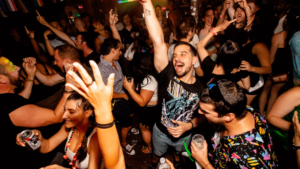‘Brand storytelling’ has become somewhat of a marketing buzz phrase in recent times. But how clear are you on what it actually means and have you wondered how it relates to your events?
In this article, we will look at how event creators can harness the power of storytelling to better engage with attendees – helping you grow beyond the walls of your event, to build a thriving community.
What does brand storytelling mean?
First, let’s start by clarifying the terminology: brand storytelling is all about helping your customers connect emotionally with your event brand. It’s the narrative that humanises what you do and speaks to your audience on a level deeper than a purely transactional one (i.e. we sell widgets, you should buy widgets from us).
Brand storytelling brings your brand to life and gives it personality. It makes it a living, breathing entity with its own thoughts and feelings. It gives it its own voice and ways of saying things, and it sets the viewpoint through which your brand sees the world.
Why worry about brand storytelling?
Your event tickets may have been selling just fine without giving any thought to brand storytelling, so why start now? Well, it may be that you have already built a strong brand personality organically, which is great. You can now crystalise this into a written document to help ensure consistency across marketing channels – and provide easy onboarding for new staff.
On the other hand, if you don’t have a distinctive brand persona, developing one can help you differentiate yourself in an increasingly competitive marketplace. Having a clear idea of who you are and what you stand for makes it easier for others to understand if you’re what they’re looking for.
This goes beyond having a great “About Us” page; marketing guru Seth Godin famously said, “People do not buy goods and services. They buy relations, stories and magic.” And what he meant was that you have to appeal to people’s imaginations when you sell to them. Brand storytelling allows you to do that.
Where to start with brand storytelling?
Every event brand has its own unique story. Here are some questions to get you thinking about it. You can either write your answers down or, if you’re not the event’s founder, record an interview with that person.
- When and where was your event launched?
- What led to you launching this event?
- What were you or other key team members doing previously?
- What did you hope to achieve through launching this event?
- How challenging was it launching this event – what have you overcome?
- How has your event changed and developed?
- Who are your event attendees and why do they attend?
- How close have you come to achieving your goals with your event?
- What are your continued mission and future ambitions?
- What wider issues or values are important to you as an organisation?
Writing down where you’ve come from and where you’re headed provides you with more strategic direction. It also helps you identify who should be joining you for the ride…
What audience are you writing for?
An important part of storytelling is understanding your audience. Take for example romance writers; they know their readers are most likely to be female, aged between 30-55, and will have certain expectations, like a handsome hero and a happy ending, so they write with this in mind.
It’s not so dissimilar when you’re crafting copy that speaks to your event attendees. To understand what stories will excite them, you need to go further than simple demographics – you need to know who they are as people. To do this, you can flesh-out target ‘personas’.
Identify the key ‘types’ who come to your event and the underlying needs each individual has, i.e. harassed mum looking for ‘me-time’, ambitious junior executive wanting to fast-track their career, or technology-tired Millennial searching for love in real life. What makes these individuals tick? What makes them ticked off? What challenges are they facing? What are they scared of? What do they dream of?
The better you can get to know your attendees, the better you can appeal to them. You can then cultivate different stories for each separate persona and reach out to those audiences with different objectives.
What is your event’s persona?
You’ve identified the characteristics of your attendees, now it’s time to turn your gaze inwards. Imagine your event brand as an actual person; give them a name if it helps, and then build out a description.
What would they look like? Would they be super-fashionable or classically stylish? What political party would they support, what bands would they like? Would they prefer an adventure holiday or reading a book on the beach?
While these questions may seem a little silly, they help you construct a tangible personality for your event brand. It then becomes much easier to work out how your event brand should express itself.
How should brand storytelling impact day-to-day communications?
You should aim to communicate your brand story through every step your customers take while interacting with your event brand on and off-site. From your website, social channels and advertising, through to your event registration, customer support and post-event thank-you.
It’s not just about keeping a consistent tone of voice; it’s about consistently inspiring people, and continually communicating your brand values. Brand storytelling is always trying to spin a narrative, tell personal stories and trigger emotional responses.
For example, if you post a behind-the-scenes photo, it’s about accompanying that with a caption that tells a story, like “Katie, our event assistant, lost her keys this morning, then she missed her bus. Bad days at Conference Corp = doughnuts.” Even the most corporate of brands can win fans and increase engagement by being relatable!
How can you keep finding original stories to tell?
Turning your event brand into a great raconteur with endless tales to tell might seem like a challenge, but you don’t just have to tell your own stories – your event attendees can be a great source of inspiration.
Sharing real customer stories builds trust and loyalty and is the best way to demonstrate what impact your event has on attendees. Make your customers part of your brand story and your communications will always feel authentic.
Conclusion
We all love a good story. So if you want your audience to sit up and listen, don’t bore them with fact and figures; give them a narrative they can engage with. Put your attendees at the centre of your story and you’ll have their attention!





